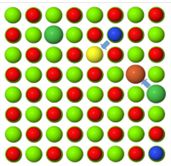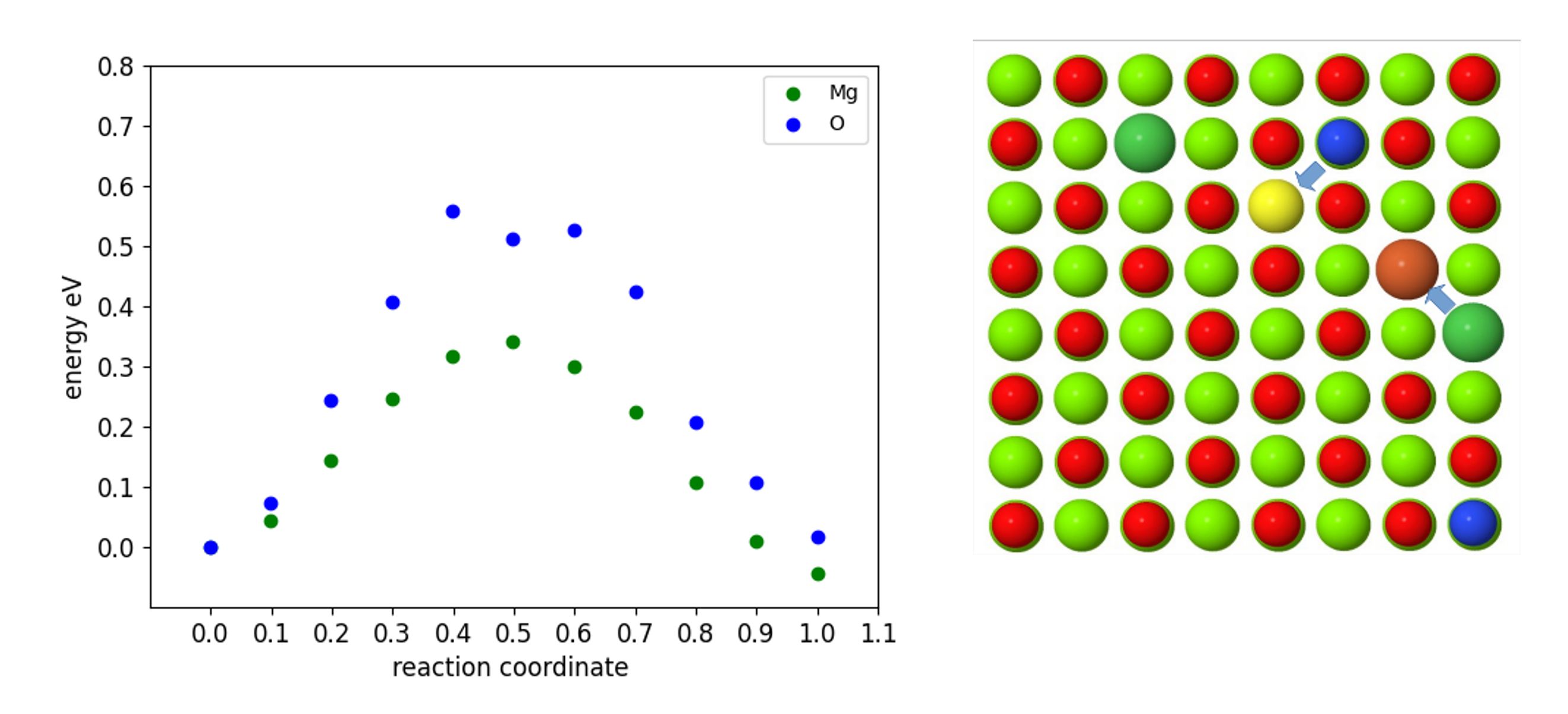Scaling up and coupling adaptive kinetic Monte Carlo with large-scale DFT
ARCHER2-eCSE05-04
PI: Prof Chris-Kriton Skylaris (University of Southampton)
Co-I(s): Dr Gilberto Teobaldi (STFC)
Technical staff: Dr John A Purton (STFC)
Subject Area:

Surface oxygen and magnesium ions are shown as blue and dark green spheres, respectively
Diffusion of atoms and ions in solid state materials is essential for the fabrication of materials and their function for technological applications such as batteries, fuel cells and magnetic materials. Understanding atomic and/or ionic diffusion is accordingly essential for the design and controlled manufacturing of novel materials. Unfortunately, computational techniques to study and analyse solid state diffusion are limited. Molecular dynamics (MD) is the technique of choice for the real-time simulation of kinetic processes in materials, however, at low temperatures MD becomes inefficient as there is insufficient thermal energy to overcome the activation energy. Thus, the simulated configuration will remain in or close to the initial state. Kinetic Monte Carlo (KMC) is capable of overcoming these large energy barriers and adaptive kinetic Monte Carlo (aKMC), as implemented in ACDC, determines the transition states and activation energies using a minimum mode following search (e.g. dimer method or activation relaxation technique) [1] so that neither the mechanism nor the end point of a process is known prior to the search.
Prior to this project, ACDC employed empirical potential models to calculate the energy and forces and, hence, sample to potential energy surface. Empirical potentials are often determined by fitting to equilibrium properties and may not provide an accurate representation of the energy barriers for diffusion. Moving out of these limitations, the objective of this project was to create an interface between ACDC and ONETEP (a linear-scaling ab initio electronic structure code) [2] so that accurate energies and forces could be used to calculate diffusion transition states.
For KMC to accurately model the diffusion processes, it is necessary to sample a large number of possible saddle points depending on the size of the system. Fortunately, as each transition state search is independent of the others, multiple searches can be launched in parallel and orchestrated to occupy thousands of cores.
Using the above interface, we have examined the diffusion of atoms on the Al (001) and MgO (001) surfaces with simulation cells containing 110 and 268 atoms and exploiting between 5,120 and 10,240 cores respectively. The calculated activation energies from ACDC-ONETEP are in good agreement with those determined from nudged elastic band calculations using VASP [3].

Figure 1. Calculated activation energies for the diffusion of a single oxygen and magnesium ion on the (001) surface of MgO, shown on the right. The surface oxygen and magnesium ions are shown as blue and dark green spheres, respectively. The trajectory of the diffusing ions is marked by the blue arrows and the final position of the ions are displayed in yellow (oxygen) and brown (magnesium).
- [1] M. Trochet et al., Handbook of Materials Modeling
- [2] J. C. A. Prentice, …, C-K. Skylaris (36 authors) (2020) J. Chem. Phys. 152:174111.
- [3] G. Henkleman, et. al., Phys. Rev. B 72, 115437 (2005) and G. Geneste, et. al., J. Chem. Phys., 122, 174707 (2005).
Information about the code
ONETEP is freely available to academics and a licence can be obtained (this includes the source code) and there is a central ARCHER2 module.
A BSD (3 clause) will be used for ACDC and an application to use this scheme has been made to STFC’s legal team. Once this has been obtained, it will be released on GitLab.
ONETEP is actively developed by core developer groups at Southampton University, Imperial College London and Warwick University plus other contributors across the EU and Asia. Modern software engineering practice is involved in its development and a continuous integration protocol is in place based on github.
A frequently updated website provides information about the code and its capabilities and outputs and provides details of the free license for academics, who can obtain the full source. There is also information about training events (including Masterclasses for users and coding retreats for developers) and tutorials, and details about how to sign up to the ONETEP mailing list.
